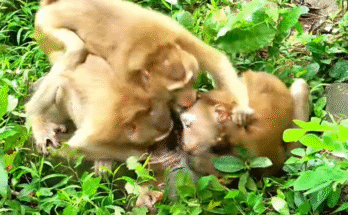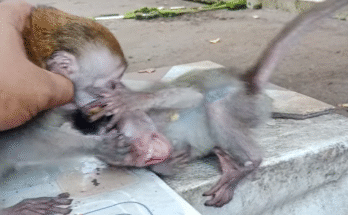Certainly! Here’s an overview of how male monkeys fight for dominance, from their early stages as babies to becoming the alpha or king of their group:
Title: How Male Monkeys Fight for Dominance: From Baby to King
Overview:
In the social world of monkeys, dominance plays a crucial role in determining access to resources, mates, and social status. Male monkeys’ journey to become the alpha—or king—begins early in life and involves a series of behaviors, competitions, and challenges.
Baby Stage:
Male monkeys start life as helpless infants, completely dependent on their mothers. During this early stage, they observe the social hierarchy around them but do not actively compete for dominance. However, even as babies, they begin to learn social cues and behaviors by watching older males, which will influence their future actions.
Juvenile and Subadult Phase:
As male monkeys grow into juveniles, they begin to assert themselves through play and minor challenges. They often engage in mock fights, mock displays of strength, and social interactions that help them learn how to compete and establish their place in the hierarchy. During this stage, they may also start to test their strength against peers, which is essential preparation for adult dominance battles.
Adult Male Competition:
Once fully matured, male monkeys enter the phase of active competition. Dominance fights involve a combination of displays, such as loud calls, chest beating, posturing, and sometimes physical battles. These fights can be intense, with males grappling, biting, and pushing each other to establish who is strongest and most fit to lead the group.
Territorial and Mating Battles:
The dominant male, or alpha, often guards the group’s territory and mates with the females. Other males may challenge the alpha through displays or actual fights. The winner gains increased access to resources and reproductive opportunities, reinforcing his status. Sometimes, the defeated males temporarily lose their status but may challenge again later.
Fighting for the Top:
The path to becoming the alpha isn’t always straightforward. Males often engage in a series of challenges, with the strongest or most strategic winning out. Physical strength, agility, intelligence, and social alliances all influence the outcome. Sometimes, younger males challenge older, established males, leading to fierce battles that can determine the group’s hierarchy.
Maintaining Dominance:
Once a male attains the position of king or alpha, he must continue to defend his status through displays of strength, confidence, and social influence. Younger rivals may continue to challenge, leading to ongoing conflicts. The alpha’s ability to maintain dominance depends on his physical condition and social skills.
Conclusion:
The fight for dominance among male monkeys is a complex mix of social cues, displays, and physical contests. From humble beginnings as helpless infants, males learn and develop the skills necessary to compete, challenge, and sometimes overthrow existing leaders to become the king of their group. These battles not only shape individual status but also influence the social structure and survival of the entire troop.
Would you like a shorter summary or a more detailed story version?


